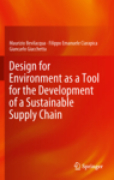
Design for environment as a tool for the development of a sustainable supply chain
Bevilacqua, Maurizio
Ciarapica, Filippo Emanuele
Giacchetta, Giancarlo
Environmental Design is becoming an increasingly significant agenda for many manufacturing companies and yet there is no standard to their approaches, strategies or their levels of execution. Applying Design for Environment (DfE) methodologies to develop a more sustainable supply chain has formed procedures and techniques which allow designers to integrate these methods with environmental supply chain management. Design for Environment as a Tool for the Development of a Sustainable Supply Chain aims to define relevant target specificationsfor a product throughout its life cycle; from conception and design to the end of its operating life. Be considering this new approach to the supply chain, environmental responsiveness can work in tandem with sounds business management. The usual focus on suppliers, manufacturers and customers is expanded in Design for Environment as a Tool for the Development of a Sustainable Supply Chain to include stakeholders such as government bodies and recycling companies. The influence of these additional groups is analyzed alongside concepts suchas:. Product life cycle development aimed at environmental impact minimization;. Supplier selection and management based on environmental criteria; and. Marketing and communication choices which increase the value of environmentally sensitive products. By including several case studies alongside theoretical topics, Design for Environment as a Tool for the Development of a Sustainable Supply Chains acts as a foundation for professionals across the supply chain, from industrial designers to marketing and sales departments, who are involvedin environmental issues. Sets target specifications for the product and its life cycle. Establisheseco-design concepts. Uses environmental management case studies to better explain the theoretical topics. INDICE: 1. Introduction. 2. Integration of Design for Environmental Concepts in Product Life Cycle. 3. Case Study: LCA as a Tool in “Design for Environmental”: A Comparative Study Between Domestic Refrigerators. 4. Sustainable Product Assessment Tools. 5. Case Study: The Domestic Cooker Hood “F77”. 6. Designers' Utilization of DfE and Requirements. 7. Case Study: Development of a Sustainable Product Lifecycle in Manufacturing Firms. 8. Design a Sustainable Supply Chain. 9. Environmental Aspects in Strategic Decisions. 10. Case Study: Carbon Footprint in the Textile Supply Chain. 11. Optimising Sustainability in Products and Services. 12. DfE Procedures in the Development of a More Sustainable Supply Chain. 13. Methods for Weighting DfE Choices in the Development of a More Sustainable Supply Chain. 14. Enviromental Marketing and Communications. 15. Corporate Environmental Policy.
- ISBN: 978-1-4471-2460-3
- Editorial: Springer London
- Encuadernacion: Cartoné
- Páginas: 371
- Fecha Publicación: 31/01/2012
- Nº Volúmenes: 1
- Idioma: Inglés
